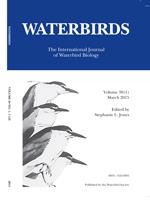The global decline in natural wetland cover has enhanced the importance of artificial wetlands, such as rice fields, as waterbird habitats. In this study, relationships of waterbird assemblages, in terms of abundance, diversity and spatial distribution to their invertebrate prey, were investigated across rice paddy fields at various growth stages in western Kenya. Waterbirds were first grouped as large or small waders and prey items as aquatic or non-aquatic. Waterbird assemblage patterns were then tested against prey abundance across three rice growth stages. Overall, waterbirds were most abundant in the middle stages of rice growth (F2,732 = 3.304, P = 0.041). The most common large waterbirds were in the Ardeidae and Threskiornithidae families, while the most common and abundant small waterbirds were in the Charadriidae and Scolopacidae families. Most small waterbirds were present in the early rice growth stages, while most large waterbirds were present in the middle stages of rice growth. Species diversity differed significantly by rice growth stage among the large but not the small waterbirds (F2,52= 4.505, P = 0.025). Abundance of small waterbirds was affected more by diversity than by abundance of their prey (R = 0.771, P = 0.034), suggesting a selective feeding strategy that may be driven by frequent mobility or density-dependent dispersal pressures during flooded-field phases. Conversely, large waterbirds were more abundant in more prey-dense areas regardless of prey diversity (R = 0.886, P = 0.024), reflecting a more opportunistic feeding strategy, exploiting both flooded and dry field stages. This strategy explained the wider spatial distribution of large waterbirds. Because of their wide selection of prey type, large waterbirds potentially play a greater role in controlling ground-level rice pests across all rice growth stages. Field management options that favor presence of large waterbirds may enhance this ecological role of natural rice pest control.
How to translate text using browser tools
1 March 2015
Role of Invertebrate Prey Abundance on Waterbird Distribution Across Rice Field Growth Stages in Western Kenya
Nickson Erick Otieno,
Alex S. Mutati,
Cynthia Akoth,
Daniel Ogwanjg,
Timothy Mwinami,
Philip Alaro,
Jeremy Njoka
ACCESS THE FULL ARTICLE

Waterbirds
Vol. 38 • No. 1
March 2015
Vol. 38 • No. 1
March 2015
abundance
Kenya
prey abundance
rice fields
waterbirds




